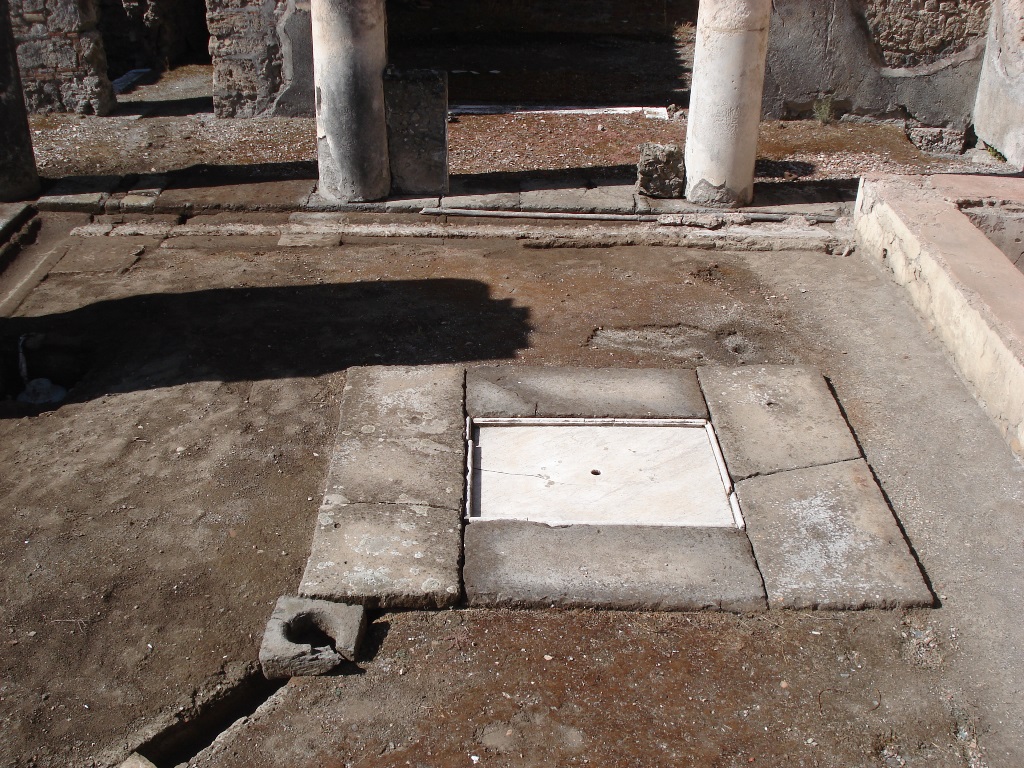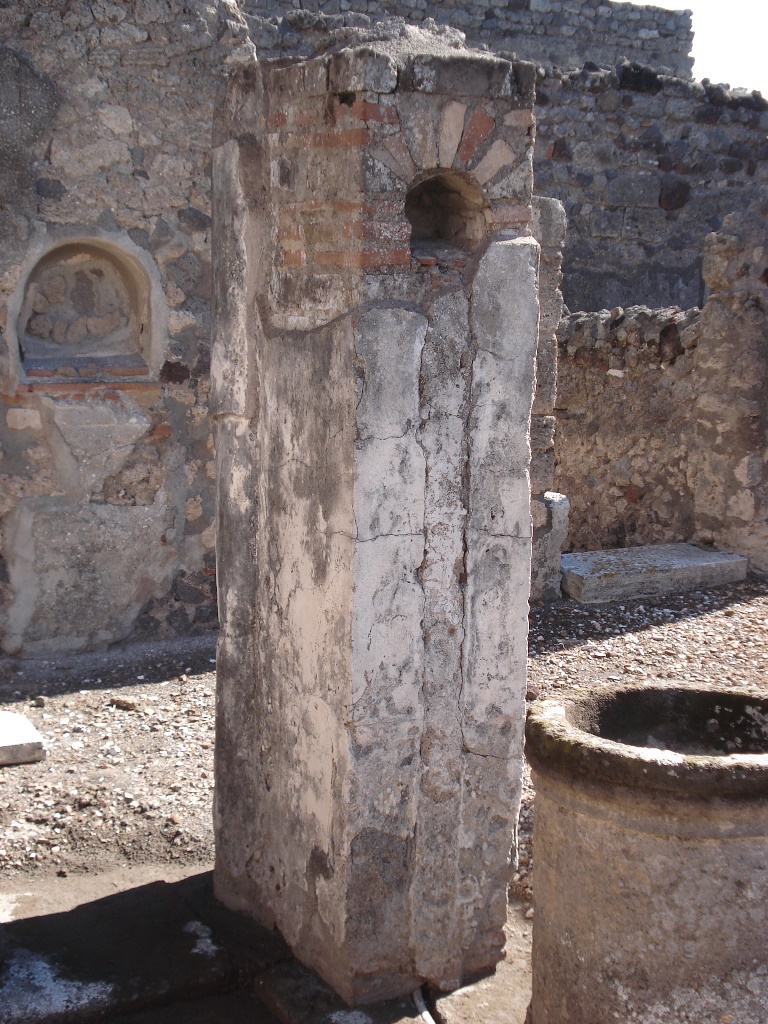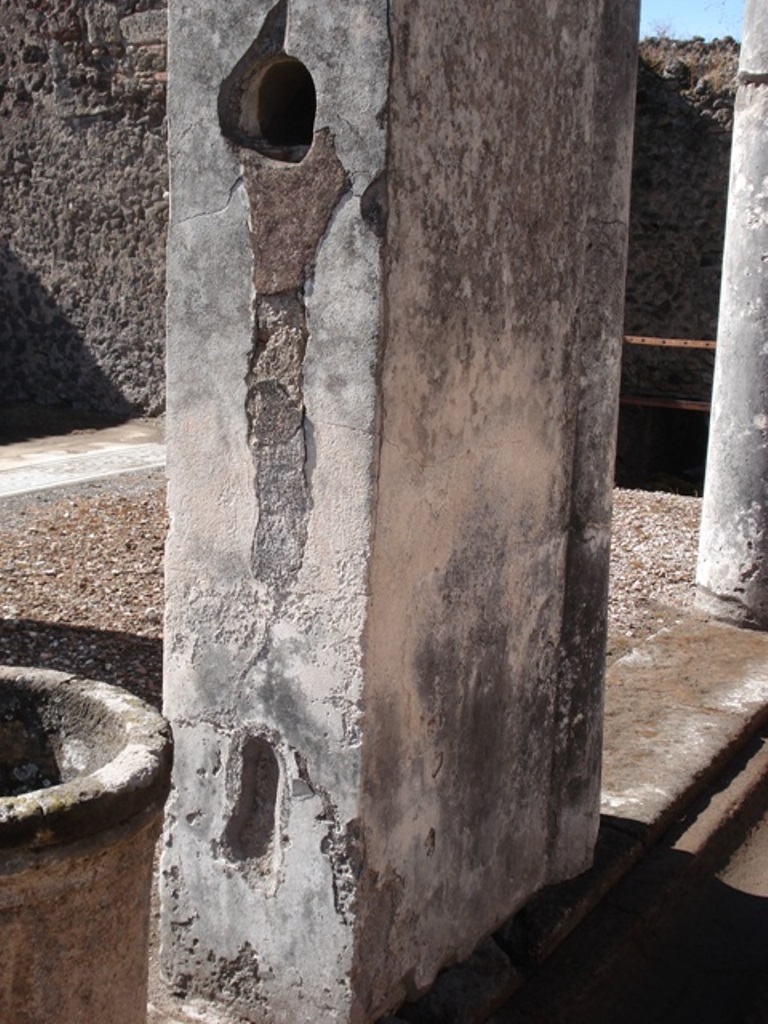Fountain 2
Description
Thomas Staub
The nymphaeum was not the only fountain arrangement in the peristyle. In front of it, another water jet was inserted in the middle of a shallow marble basin, framed by tufa stone blocks, which livened up the central part of the garden. The water from this basin was led towards the gutter in front of the eastern portico by means of a channel. It has been suggested that the area around this basin functioned as an outdoor triclinium, furnished with transportable clinae (Andersson 1990, 225 — 230). This interpretation seems unconvincing; a garden function seems more accurate.
Also two of the porticoes framing the garden were adorned by water installations. In the southern one, the width of the easternmost intercolumnium was doubled by the removal of one column. In this new intercolumnium two shear walls were attached to the two framing columns. On the front face of each of these walls a small vaulted cavity was inserted in which the remains of lead pipes are still visible. From these cavities the water poured down into two hollow tufa stone cylinders, from where it overflowed into the garden gutter through a probable inclination of the cylinders towards the north.
Similar fountain arrangements can be observed in the western portico, but without the cylindrical water-collecting vases and with the difference, that the pillars where the pipes are inserted are lower - only about 1.10 m high. Here the water spouted directly into the gutter or channel of the peristyle. In this portico the small pillars seem to be a late addition, even later than the ones in the southern portico, since the walls here abut the latest plaster on the columns (On these fountains, see Andersson 1990, 220f).
Together with the water from the fountain in the centre of the garden, the water from these fountains in the porticoes was collected in a cistern. Its entry as well as the cistern mouth is placed at or in the eastern portico. Only when the cistern was full was the excess water directed through a channel towards the eastern side street.
The decorative water installations in the peristyle of the Casa del Torello underwent repairs and alterations but probably also extensions. A lead pipe enters the lower socle to the west of the nymphaeum. Earlier it was interpreted as the water inlet supply to the house, entering from the adjacent Casa di Caecilius Iucundus (For this interpretation, see Andersson 1990, 224). Since we have found the main inlet to the nymphaeum elsewhere and there is no corresponding water pipe on the other side of the separation wall between the two properties (in the rear part of Iucundus' garden) this suggestion is assuredly wrong. Instead, this pipe, which was cut off in antiquity, led to a further fountain, which may have once stood on top of this bench. If so, the same should be proposed also for the corresponding postament at the eastern side. As the centre of its upper side is covered by modern concrete, this function of the pipe could not be totally confirmed but is probable. A further, apparently unconnectedd lead pipe enters the west side of the parapet wall of the basin. This could be the remains of an older water feed to the fountains in the niches, cut off in a later period, perhaps due to some repairs of the nymphaeum, following the burst of a pipe. This could then also explain the discrepancy noted earlier between the design and use of material for the mosaic plates, which are generally set quite early in the development of fountain — and wall mosaics and the painted decoration of the façade, which clearly belongs to the Fourth Style.
Besides these repairs further changes have been observed. Since remains of only one older pipe enter the side wall of the basin, probably being the original pipe serving the fountains in the niches, the row of small water jets on its top is probably a later addition. This was probably contemporary with the small water distribution box to the west of the basin, serving to operate the fountains here. It also concerns the basin in front of the nymphaeum which in its interior is tripartite, separated by means of low walls. The water could circulate between the three sections through lead pipes inserted near the bottom of these dividing walls. A closer study has revealed that originally this circulation was enabled by means of pairs of larger apertures (diam. 0.11m) in the centre of the walls (See Staub 2008, 113. For a similar arrangement in the Casa del Granduca (VII 4,56), see Staub Gierow 1994, 35, and Sear 2004, 159 f). Such tubes have been interpreted as being connected to the breeding of fresh fish in fountain basins (See Zanker 1979, 503). If this explanation is correct, the fish culture was later abolished in our house, maybe because the water in the basin became too disturbed after the installation of the large number of small water jets on the top side of the framing wall. Also the pair of fountains in the western portico seems to belong to a later phase. This is indicated by the fact that the low shear walls are put up against the last layer of plaster on the attached columns in contrast to the situation in the southern portico, where the plaster extends over both the columns and the shear walls. Also the discrepancy in the execution of the carving in the tufa stone blocks of the stylobate for placing the pipes indicates a later addition of the fountains in the western portico: here the work in the southern portico shows a very accurate execution, whereas the corresponding work in the western portico is very rough and more shallow.
Even for the fountains in the southern portico several building phases have been proposed (Andersson 1990, 217), since on the front side of the east pilaster one can observe a line covering the plaster along the channel for the pipe, which might indicate a later installation of the fountain; however, since the plaster in the lower parts of the corresponding western section covers the channel, it seems that the fountains were installed at the time when these structures were built. The repair on the eastern side is either due to the continuous humidity from the pipe or could have become necessary after a break in the pipe. That this must have happened quite often in Roman times can also be seen in Ovid's Metamorphoses. In the story about Pyramus and Thisbe, he uses the image of a bursting pipe to describe the flow of blood from Pyramus' mortal wound. Ov. Met., IV, 122 ff.
In addition to the different decorational effects that were created by the fountains, other aspects were also appreciated in Roman antiquity: one of these is the sound by the splashing made by the water as it falls into its recipient. This is known to us through a letter by Pliny the Younger (Plin. Epist. 5, 6, 23) and a passage in the Appendix Vergiliana (Appendix Vergiliana, Copa, v. 9 — 12). This effect must have been quite strong, especially in the peristyle. Here not only would the large amount of fountains have created not only a loud noise, but probably also a much diversified one. This is due to the different shape, size and materials used for the different recipients and the height of the fall of the water: the sound of the water cascading down into the tufa stone drums in the southern portico would certainly have differed from the tinkling of the water from all the small water jets on the upper side of the basin and the waterspout fountain in the shallow marble basin in the centre of the garden.
Another effect created by fountains that is mentioned in a passage in the ancient Roman literature concerns thermal comfort. In his “de re rustica' Columella praises the cooling effect of the falling water in the summer heat (Colum. De Re rustica, 1, 5, 4). This effect could probably have been felt in the peristyle, due once more to the large amount of fountains spitting out cold water. But that effect could have be achieved even in the atrium, here due to the size of the impluvium (approx. 5.5 m²), that was continuously refreshed by cold water when the fountains were on. Thus, to a certain extent, it functioned like a modern air conditioner.



